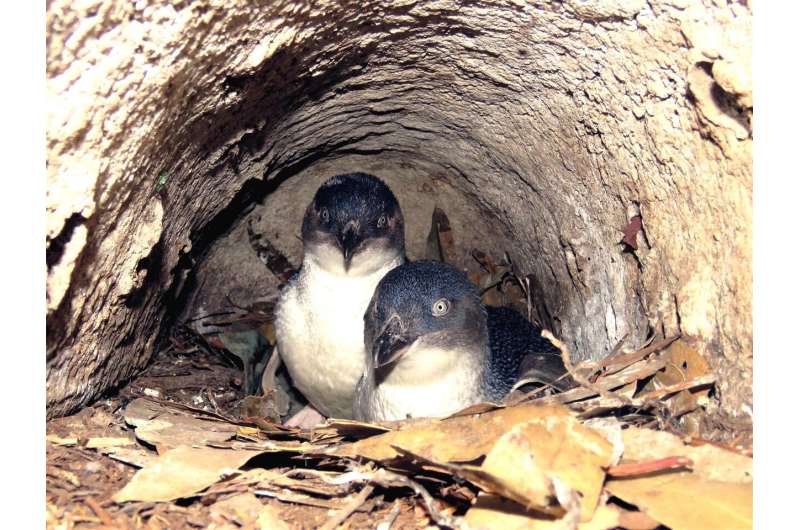Credit: Institute for Marine and Antarctic Studies (IMAS)
A study of little penguins in southeastern Tasmania has shed light on how the marine predators adapt to subtle changes in environmental conditions to find food.
To record their foraging behavior, little penguins from three colonies around Storm Bay were fitted with GPS trackers by a team of IMAS and CSIRO researchers.
The study, published in the journal Marine Ecology Progress Series, is the first to provide information on how Tasmanian little penguins behave at sea.
It found the birds remain relatively close to the coast, exhibit a high level of variability between colonies while accessing a wide variety of sites, and are finely attuned to environmental influences such as water depth, salinity and temperature.
The study's lead author, former IMAS Honours student Lachlan Phillips, said conditions in Storm Bay are highly variable and affected by a wide range of factors, including the East Australian Current, cold sub-Antarctic waters in winter, and fresh water from the Derwent and Huon rivers.
"We wanted to see how little penguins from three separate colonies adjusted their foraging behavior to the varying conditions they experience," Mr Phillips said.
"Previous studies have looked at how environmental conditions influence marine predator behavior on a broad scale but little is known about the impact of localized factors, such as those in complex environments like Storm Bay.
"We put GPS tags on 29 little penguins from colonies near Kingston and on Bruny and Wedge islands and collected data at a one to two-kilometer resolution every hour, before removing the trackers after 24-hours."
Mr Phillips said penguins from the three sites behaved quite differently while foraging and their behavior was influenced by distinct environmental variables.
"The Bruny Island penguins traveled the greatest distances and their foraging behavior was influenced by sea surface height and tidal flow.
"Wedge Island penguins made the shortest trips and their behavior correlated to water temperature and salinity, while individuals from near Kingston had the longest trip duration and adapted their behavior in line with water depth," Mr Phillips said.
Co-author IMAS Associate Professor Mary-Anne Lea said the variations in conditions experienced by penguins affect the distribution of their prey.
"When foraging, marine predators need to respond to environmental conditions in order to locate their preferred food," Associate Professor Lea said.
"For example, cold ocean eddies and river mouths are associated with high levels of nutrients that support phytoplankton and therefore attract fish that penguins prey on.
"Cooler and less saline sub-Antarctic waters are preferred by a species of krill found in southern Australian waters, which in turn also attract fish and penguins.
"As conditions change in highly variable and complex environments such as Storm Bay so too do the locations where little penguins can find food.
"Penguin foraging behavior is also affected by other factors, such as colony location and their breeding cycle.
"Studies such as this highlight the significance of fine-scale environmental variability in determining the foraging behavior of marine predators such as penguins," Associate Professor Lea said.
Associate Professor Lea said getting a more complete understanding of penguin activity and behavior around Tasmania would require longer-term research to study colonies across the State.
More information: LR Phillips et al. Variability in at-sea foraging behaviour of little penguins Eudyptula minor in response to finescale environmental features, Marine Ecology Progress Series (2019). DOI: 10.3354/meps13095
Journal information: Marine Ecology Progress Series
Provided by Institute for Marine and Antarctic Studies (IMAS)
























